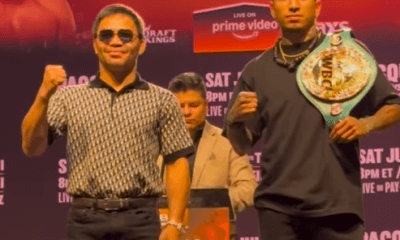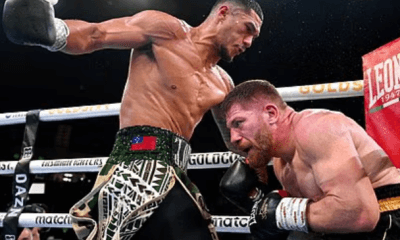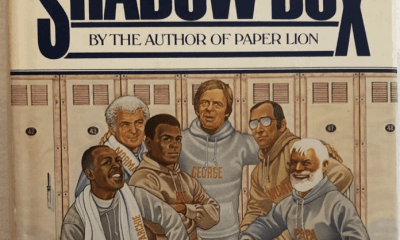Featured Articles
Manny Pacquiao Returns…
Manny Pacquiao returns to the ring this weekend against Brandon Rios in Macau, China, almost one full year after he was bludgeoned down to the canvas by archrival Juan Manuel Marquez. Most fighters are unable to recover from such a knockout. Their career would be over the way a chicken’s life is over when you remove its head. Sure, it flails and kicks around like it’s still alive, but that chicken is dead.
In 1986, a four-issue comic book series called The Dark Knight Returns was published by DC Comics. The story was written by Frank Miller, who co-illustrated it alongside Klaus Janson. The plot follows a 55-year-old Bruce Wayne, as he dons the batsuit once again after a long retirement to fight crime in Gotham City.
Batman faces both new foes and old. He thwarts a gang of criminals called the Mutants, dukes out a final round against his arch-nemesis, the Joker, and even takes down Superman after the hulking alien is sent to Gotham to stop Batman’s vigilante efforts once and for all. The series was later collected into a single volume graphic novel, and is considered by critics one of the finest examples of storytelling and art in the genre.
For those more familiar with the movie version of Batman, particularly the one portrayed by Christian Bale and directed by Christopher Nolan, many of the motifs present in the third and final installment of the trilogy, The Dark Knight Rises, were borrowed from Miller’s comic book classic.
Most applicable to this essay, are three elements: Batman’s return to crime fighting after a long layoff; Batman facing younger, stronger and faster adversaries; Batman inspiring Gotham City one more time.
A Return to Familiar Places
Like Batman’s return to Gotham City, Pacquiao will be returning to a familiar environment on Saturday night, one he has previously mastered. Where only the top one percent of boxers ever carve out a living in the sport, only a fraction of those who do also reach both the historical and financial levels of success Pacquiao has attained.
But the ring is an unforgiving environment. Fighters age out faster than perhaps in any other sport. Unlike team sports, there is no roster spot to hide a player with diminished skill. And unlike other individual sports, such as tennis or golf, boxing is combat. The goal is not to hit a ball, but an opponent. Boxing is the roughest of pastimes. Fighters get old almost overnight. One day, you’re at the top of the sport. The next, you’re lying face down in the rubble.
It’s the same for Batman in The Dark Knight Returns. Where characters like Superman, Spiderman, Hulk, Thor, etc. all possess alien, magical and/or mutant superpowers, Batman is just a man. Sure, he’s big, fast, strong and skillful, but Batman has no more physical or mental attributes than any other human could have, except that in this story he has aged past his physical prime. In that way, the fictional Batman is of the realistic variety, as far as comic book heroes go.
Like Pacquiao (seen above arriving in Macau with wife Jinkee, in Chris Farina-Top Rank photo), the Batman of The Dark Knight Returns isn’t what he used to be. But Batman is still enough of what he was to look like Batman to everyone else, including his antagonists.
Is Pacquiao the same?
Facing the Young Brutes
There is no senior circuit or masters tour in boxing. In fact, in order to stay in the fight game as an elder statesmen, one has to beat back the younger, stronger and usually hungrier fighters coming up to take your place. Only the very best fighters in boxing history have done this for an extended period of time. And some of the greatest fighters ever were unable to do it at all. Roy Jones, Jr. was knocked out cold at age 35 by Antonio Tarver, who was the same age but had carried much less ring wear into the fight because of a late starting career. Muhammad Ali was a shell of himself at age 36 when he lost a split decision to 24-year-old Leon Spinks. Jones and Ali never looked the same. Pacquiao, 34, will face a 27-year-old Rios this weekend.
In The Dark Knight Returns, Batman is 55-years-old. Fans of the comic will remember him looking even older than that in the comic’s artwork. While Batman does face some old nemeses, men like Harvey Dent (Two Face) and the Joker, the predominant enemies Batman must tussle with are not his contemporaries at all. Through most of the narrative, Batman faces a new gang of thugs called the Mutants. They’re young. They’re strong. But he’s Batman.
Batman faces the leader of the Mutant gang twice. The first time he rumbles with the younger, stronger and more youthful Mutant leader, Batman tries to fight him as if they were similar in age and vigor. He almost loses his life in the process, barely escaping. The second time, Batman uses guile to lure the leader into a mud pit where Batman can keep the Mutant leader from having any advantage in speed. The rest is all bravery and cunning. Batman defeats the leader of the gang, and the rest of the criminals are rounded up and put into jail.
While Batman had to think differently than when he was a younger man, he didn’t change his style. He was still Batman in form and function. Rather, Batman recognized his strengths and weaknesses to that of his opponent. Moreover, he was honest with himself in assessing a much smaller margin for error against opponents at his advanced age. Like Batman, Pacquiao will still need to be himself against his adversaries. But he’ll need to be smarter and fight with more attention to detail than he has in the past.
Something to Believe In
On November 8, 2013, Super Typhoon Haiyan (also known as Yolanda) barreled through the Philippines wreaking havoc on thousands of local inhabitants. CBS News reports Yolanda might become the area’s deadliest natural disaster on record. As of Sunday, the rising death toll was almost 3,500 souls, with almost 1,200 missing and 13,000 reported injured.
Whether it is right or wrong, many in the Philippines will seek a diversion from their sorrow and angst through their love of national hero Pacquiao. To his credit, Pacquiao recognizes this and has dedicated the fight to his country and the victims of Super Typhoon Haiyan.
The phenomenon of coping with tragedy through sports is not localized to the Philippines at all. Americans will remember how venerated the New England Patriots were after the September 2011 terror attacks, how eagerly the New Orleans Saints were cheered for after Hurricane Katrina leveled the city in 2005, and how important the Boston Red Sox were for many after this year’s Boston Marathon bombing.
In Miller’s The Dark Knight Returns, Batman serves the same function for the inhabitants of this fictional, dystopian future. Part of the comic’s narrative is aimed at describing the polarizing views that grow more and more rampant in a society with a two-party political system. But the narrative is also about the effect a galvanizing force can have on a group of people. By the end of the story, Batman is the leader of an ardent group of loyal followers who believe in him and his cause. They don’t just believe in him because of what he is. They believe in him because of what he stands for, and more importantly what they believe he stands for.
The people of Gotham live in a world where bad is celebrated as good, where right is wrong, where down is up. They rally behind Batman, not as a man really, but as a symbol of hope. The motif is probably better realized (or at least more accessible) in Nolan’s movie, The Dark Knight Rises. For the people of Nolan’s universe, Batman is who rallies them to rise against the menacing bandits who take over the city and hold it hostage.
Like the fictional Batmans in Miller’s The Dark Knight Returns and Nolan’s The Dark Knight Rises, real life Pacquiao will be asked to provide a symbol of hope after a desperate and trying time. It might not be fair, but it’s reality.
Pacquiao is a favorite against Rios, and he absolutely should be. While Rios is a tough-nosed fighter with hard punches and a brave chin, Pacquiao has everything in his tool bag that Rios can’t handle. When the two meet on Saturday, Pacquiao won’t need to go to the same lengths Batman did against the Mutant leader in order to win. He won’t have to lure him into mud to slow Rios down. Pacquiao is already much faster than Rios. And while Rios has a good punch, Pacquiao will likely hold the edge in power, too. In fact, the only tangible elements Rios will have on his side this Saturday night is youth and size. And he probably doesn’t have enough of either of them to beat Pacquiao, who still appears closer to a hero than a has-been.
And After All This, There’s Just One More Thing: $uperman
After facing Rios, Pacquiao has several notable options to pursue. First and foremost on the list should probably be Timothy Bradley, who was awarded a controversial decision win over Pacquiao in 2012 (even though almost everyone else in the world thought Pacquiao deserved the nod easily). After that, Pacquiao would probably seek a fifth tussle with archrival Juan Manuel Marquez. Marquez knocked out Pacquiao last December, but did so after appearing to be on his way to a loss. Pacquiao holds a 2-1-1 edge on the fighter, and would probably take the fifth fight, too.
But those are Pacquiao’s normal foes. Akin to Batman facing Two Face and the Joker, Pacquiao isn’t treading new water in this part of narrative. But maybe, like Miller’s comic book, the final act will be the most interesting.
Because if there’s a Superman in the boxing universe, he’s wearing a ‘$’ symbol instead of an ‘S’. His name is Floyd Mayweather, and it would be the perfect way to end the story. Like Batman vs. Superman, Pacquiao would be the underdog against Mayweather. But unlike the fictional Superman, Mayweather is only flesh and blood.
Regardless, it’s perhaps most simply put like this. Superman might be the most powerful hero in the DC universe, but Batman would be on the shortlist of those who might be able to take him down. And while Mayweather is probably the best boxer of his era, Pacquiao has all the tools to give him the most trouble should the two ever meet inside a boxing ring. So much so, in fact, that Mayweather has never seemed super interested in facing Pacquiao in the first place.
And maybe that says it all. Maybe Mayweather knows he’s Superman alright, but that he’s still not the main character of the narrative. Maybe he knows he’s stuck playing the bit part at the end of a Batman story. Maybe he’s read Miller’s The Dark Knight Returns and knows how the story ends. Maybe he knows Pacquiao is the hero. Maybe he knows Pacquiao is the winner.
Or maybe this essay has spun too far out into the world of meta-narratives, and you should just enjoy the fight. After all, that’s when Manny Pacquiao returns…
-

 Featured Articles3 weeks ago
Featured Articles3 weeks agoAvila Perspective, Chap. 330: Matchroom in New York plus the Latest on Canelo-Crawford
-

 Featured Articles2 weeks ago
Featured Articles2 weeks agoVito Mielnicki Jr Whitewashes Kamil Gardzielik Before the Home Folks in Newark
-

 Featured Articles4 weeks ago
Featured Articles4 weeks agoAvila Perspective, Chap 329: Pacquiao is Back, Fabio in England and More
-

 Featured Articles3 weeks ago
Featured Articles3 weeks agoOpetaia and Nakatani Crush Overmatched Foes, Capping Off a Wild Boxing Weekend
-

 Featured Articles2 weeks ago
Featured Articles2 weeks agoCatching Up with Clay Moyle Who Talks About His Massive Collection of Boxing Books
-

 Featured Articles4 weeks ago
Featured Articles4 weeks agoFabio Wardley Comes from Behind to KO Justis Huni
-

 Featured Articles1 week ago
Featured Articles1 week agoMore Medals for Hawaii’s Patricio Family at the USA Boxing Summer Festival
-

 Featured Articles4 weeks ago
Featured Articles4 weeks agoDelving into ‘Hoopla’ with Notes on Books by George Plimpton and Joyce Carol Oates















